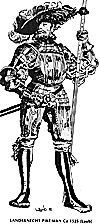 Some time ago Robert Mosca wrote an article for this
magazine introducing the reader to Renaissance wargaming.
With the introduction of Ral Partha's stunning Conclottiere
line the 1450-1550 period seems to be increasing in
popularity. The purpose of this article is to pursue this
interesting yet somewhat difficult subject, to help the gamer
who is new to the subject to avoid some widespread
misconceptions, and to suggest some historical scenarios
that might be adapted to the wargame table.
Some time ago Robert Mosca wrote an article for this
magazine introducing the reader to Renaissance wargaming.
With the introduction of Ral Partha's stunning Conclottiere
line the 1450-1550 period seems to be increasing in
popularity. The purpose of this article is to pursue this
interesting yet somewhat difficult subject, to help the gamer
who is new to the subject to avoid some widespread
misconceptions, and to suggest some historical scenarios
that might be adapted to the wargame table.
At right: LANDSKNECHT PIKEMAN Ca 1525 (Laub)
Probably the main reason that this era is so interesting is the multiplicity of effective troop types. Only during the Italian Wars can we see masses of pikemen, halberdiers, sword and buckler men, crossbowmen, arquebusiers, light cavalry, heavily armoured gendarmes on barded horse, and artillery each forming an integral, perhaps decisive part in the order of battle. Yet the results of those interactions were often startling. When the French hired the Swiss as mercenaries they combined the best infantry with the finest cavalry and most powerful artillery in Europe. After brushing aside the Italians at Fornovo, however, the Franco-Swiss coalition proceeded to lose their five major engagements together over the next twenty-five years.
The major difficulty in studying Renaissance warfare is that there are relatively few good sources, and even these are not easily obtainable without access to a major libray. Sources are listed after this article, but those readily available are only the Osprey books by Douglas Miller, The Swiss at War and The Landscknects, as well as George Gush's Renaissance Warfare. To illustrate the difficulties in pursuing the subject further, in both the Osprey books the entire bibliography is in German.
There is also one boardgame on the market which deals with the years 1450-1550. This is Yeoman, from SPI's "Prestags" series. Each scenario is followed by a short paragraph describing the engagement, and it is indicative of how poorly this period is understood to see all of the basic errors contained in those descriptions. The "Hericourt" scenario is followed by a nice description of Grandson.
Of Ravenna, it is said, "The French infantry, generally Swiss pikemen. . . ." when no Swiss are present. In fact, this is the only French-Imperial battle in which the Swiss were not the bulk of the French infantry. The battle of Ceresole is dated 1522 and placed between Biocca (1522) and Pavia (1525) when is actually took place twenty years later, and belongs to a different war.
Tactical descriptions of Fornovo and Ravenna are also erroneous, probably because the designer's purpose was to demonstrate how heavy cavalry had lost its effectiveness, and therefore their part goes unmentioned when they were the decisive arm. The point here is not to be picky with SPI, but rather to demonstrate that this period is often superficially bypassed. If someone had placed Leipzig before Austerlitz, for example, or talked of Roman legionaires at Arbela, it probably would not have been published.
Before proceeding to the scenarios, I would like to reemphasize a point made by Mr. Mosca in his article. The one type of battle which should be avoided when simulating Renaissance engagements is that old favorite, the "battle by agreement" in which both sides line up facing each other across a field and have at it. There are two reasons why this is so: one, there is not much generalship involved in having two large, practically immobile masses of pikeman with no realistic alternative to bashing head on into each other, and two, it simply did't happen that way.
Of the major engagements in the 100 year period only Ceresole was fought in such a manner. Cerignola and Ravenna were close, though in both cases the Spaniards were entrenched. The major exceptions were Grandson, Morat, Nancy, Fornovo, the Garigliano, Novaro, Marignaro, the Sesia, and Pavia. (Bicocca was more of an assault on a fortress than a pitched battle.) Nor is it simply coincidental that battles of this period did not consist of both sides "squaring off". It was a major point of the Swiss system to take the enemy by surprise before he could unravel his convoluted battle formation. Similarly, Spanish generals such as Gonsalvo and Pescara were not only usually grossly outnumbered, but were also aware that their troops were no match on a man for man basis in a toe-to-toe slugging match with French gendarmes and Swiss pikemen, so they resorted to various stratagems.
The moral is obvious if you want to recreate the spirit of Renaissance battle, choose disproportionate armies and give one a flanking position, an entrenchment, or a surprise attack. Which is another reason why reference to historical scenarios is important.
Of the following scenarios, Grandson and Morat are dealt with at length in Miller's work. However they are difficult to understand without being related to topography, and he did not present maps. This account will be drawn largely from Kirk, who presents things from the Burgundian standpoint and differs significantly in his account of Morat from The Swiss At War.
More Swiss
-
Renaissance Swiss: Introduction
Renaissance Swiss: Battle of Grandson: March 2 1476
Renaissance Swiss: Battle of Morat: June 22 1476
Renaissance Swiss: Battle of Fornovo: July 6 1495
More Renaissance
Back to Table of Contents -- Courier Vol. III #6
To Courier List of Issues
To MagWeb Master Magazine List
© Copyright 1982 by The Courier Publishing Company.
This article appears in MagWeb (Magazine Web) on the Internet World Wide Web.
Other military history articles and gaming articles are available at http://www.magweb.com